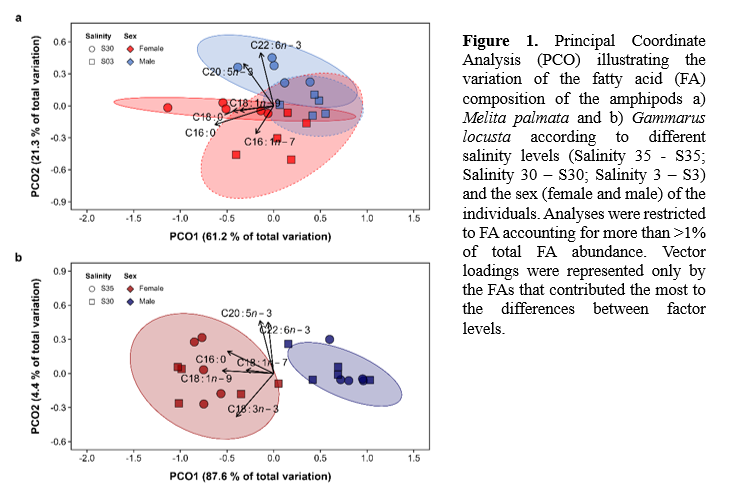FATTY ACID COMPOSITION OF AMPHIPODS IN BRACKISH AND MARINE ENVIRONMENTS
Introduction
Salinity gradients play a crucial role in coastal ecosystems by supporting biodiversity, regulating nutrient cycling, and contributing to overall ecosystem resilience. Marine organisms depend on specific salinity ranges for optimal physiological function, and deviations from these ranges can impair organism health and trigger cascading effects on population dynamics and ecosystem stability. Understanding how salinity variation influences marine organisms and how it relates to biological features such as sex is essential, as it directly impacts key cellular processes , such as lipid metabolism and the structural integrity of cell membranes. A ssessing the factors that shape the lipid composition of marine organisms is key for aquaculture species, as optimizing lipid profiles can enhance their nutritional value and improve survival rates during early life stages . At a production level , such insights can improve species selection, refine rearing protocols, and support effective water quality management . In this study, we investigated whether the fatty acid (FA) composition of two gammarid amphipod species, Melita palmata and Gammarus locusta , differs between males and females, as well as in response to salinity variations along a natural gradient in Ria de Aveiro coastal lagoon (Portugal). Special emphasis was placed on eicosapentaenoic acid (EPA) and docosahexaenoic acid (DHA), given their essentia l roles in cellular homeostasis and nutritional value for marine species .
Materials and methods
Three sampling sites were selected along Mira channel (Ria de Aveiro, Portugal), encompassing a natural salinity gradient from marine to freshwater conditions : S35 (~35 salinity), S30 (~30 salinity ), and S3 (~3 salinity). Fatty acid methyl esters were individually extracted from M. palmata and G. locusta adult amphipods using gas chromatography-mass spectrometry (GC-MS) . The overall abundance of the most important FA (measured as μg of FA per mg of amphipod dry weight) , including EPA and DHA, was compared separately for each species between salinities and sexes using a multivariate approach. Differences in the abundance of each FA between the same factors were assessed through univariate linear models.
Results
The overall FA composition of M. palmata varied significantly with both salinity and sex (Fig. 1a). Regardless of the salinity level, females showed a higher FA abundance than males ( females: 14.3 μg.mg⁻¹; males: 11.1 μg.mg⁻¹ ). Additionally, amphipods from the high- salinity site exhibited greater total FA content compared to those from the low- salinity site (S30: 14.6 μg.mg⁻¹; S3 : 10.8 μg.mg⁻¹ ). In contrast , the overall FA composition of G. locusta differed according to sex (females: 17.2 μg.mg⁻¹; males: 7.5 μg.mg⁻¹) but not between salinity levels (S35: 24.45 μg.mg⁻¹ ; S30: 24.85 μg.mg⁻¹ ), with higher content for females than males (Fig. 1b). Salinity gradients significantly influenced the FA composition of M. palmata , with high-salinity conditions promoting the accumulation of EPA and DHA, regardless of sex. In contrast, while salinity had no measurable effect on the FA composition of G. locusta, females consistently exhibited nearly three times higher levels of EPA and DHA, when compared to males.
Discussion
The observed differences in FA composition suggest that each species employs distinct strategies to cope with environmental salinity stress. In both gammarid amphipod species, females exhibited higher FA content than males , likely reflecting the greater energy demands associated with reproduction. Melita palmata showed high plasticity along the salinity gradient, with significant variation in FA composition being lin ked to both salinity and sex. This indicates that M. palmata is well-adapted to dynamic estuarine conditions and may possess a flexible metabolic strategy beneficial for survival and potentially valuable for aquaculture in environments with variable salinity. In contrast, G. locusta exhibited a strong sex-related difference in FA composition, but no significant response to salinity , probably due to the limited salinity variation between the sampled locations . Nevertheless, t hese results suggest that in aquaculture settings , favouring an all-female population, whether through selective rearing or sex-inducing technologies , can enhance biomass yield and profitability, owing to females’ superior FA composition.
Conclusion
Salinity- and sex-specific patterns in M. palmata and G. locusta revealed that salinity conditions can shape the FA composition of each species, affecting males and females differently. These patterns highlight the species’ capacity to tolerate moderate salinity fluctuations, reflecting their adaptability to dynamic coastal environments . Beyond advancing our understanding of salinity-driven physiological adaptations in marine and estuarine amphipods, this study offers valuable insights for improving aquaculture practices . By examining how salinity influences FA composition, particularly the levels of EPA and DHA, our findings can support more informed decisions on species selection and salinity management to enhance the nutritional value of cultured organisms.
Acknowledgements
This study was performed under the scope of project “BLUE BIOECONOMY PACT” (Project Nº. C644915664-00000026), co-funded by the Next Generation EU European Fund, under the incentive line “Agendas for Business Innovation” within Component 5—Capitalization and Business Innovation of the Portuguese Recovery and Resilience Plan (RRP), as well as under the scope of project “PUFAPODS Merging blue and green food systems - Using marine gammarid amphipods supplied with plant food processing side streams to produce n-3 LC-PUFA” which is supported by FCT/MEC https://doi.org/10.54499/2022.01620.PTDC. We also thank the financial support to UID Centro de Estudos do Ambiente e Mar (CESAM) + LA/P/0094/2020 through national funds.
